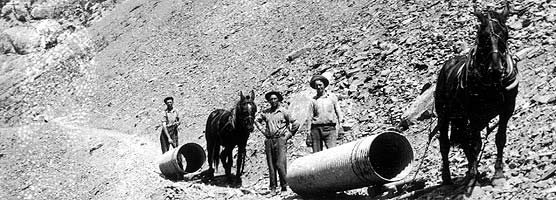 |
 | |
  | |
|
|
|
|
Glacier National Park
History & Culture
|
|
|
|
|
|
 |
 |
| NPS photo | | Tipi at Sunset |
 |
Before the Park
Recent archaeological surveys have found evidence of human use dating back over 10,000 years. These people may have been the ancestors of tribes that live in the area today. By the time the first European explorers came to this region, several different tribes inhabited the area. The Blackfeet Indians controlled the vast prairies east of the mountains. The Salish and Kootenai Indians lived and hunted in the western valleys. They also traveled east of the mountains to hunt buffalo.
In the early 1800’s, French, British, and Spanish trappers came in search of beaver. In 1806, the Lewis and Clark Expedition came within 50 miles of the area that is now the park.
As the number of people moving west steadily increased, the Blackfeet, Salish, and Kootenai were forced onto reservations. The Blackfeet Reservation adjoins the east side of the park. The Salish and Kootenai reservation is southwest of Glacier. This entire area holds great spiritual importance to the Blackfeet, Salish, and Kootenai people.
The railroad over Marias Pass was completed in 1891. The completion of the Great Northern Railway allowed more people to enter the area. Homesteaders settled in the valleys west of Marias Pass and soon small towns developed.
Under pressure from miners, the mountains east of the Continental Divide were acquired in 1895 from the Blackfeet. Miners came searching for copper and gold. They hoped to strike it rich, but no large copper or gold deposits were ever located. Although the mining boom lasted only a few years, abandoned mine shafts are still found in several places in the park.
|
 |
| NPS photo | | George Bird Grinnell |
 |
Establishing the Park
Around the turn of the century, people started to look at the land differently. Rather than just seeing the minerals they could mine or land to settle on, they started to recognize the value of its spectacular scenic beauty. Facilities for tourists started to spring up. In the late 1890's, visitors arriving at Belton (now called West Glacier) could get off the train, take a stagecoach ride a few miles to Lake McDonald, and then board a boat for an eight mile trip to the Snyder Hotel. No roads existed in the mountains, but the lakes allowed boat travel into the wilderness.
Soon people, like George Bird Grinnell, pushed for the creation of a national park. Grinnell was an early explorer to this part of Montana and spent many years working to get the park established. The area was made a Forest Preserve in 1900, but was open to mining and homesteading. Grinnell and others sought the added protection a national park would provide. Grinnell saw his efforts rewarded in 1910 when President Taft signed the bill establishing Glacier as the country's 10th national park.
After the creation of the park, the growing staff of park rangers needed housing and offices to help protect the new park. The increasing number of park visitors made the need for roads, trails, and hotels urgent. The Great Northern Railway built a series of hotels and small backcountry lodges, called chalets, throughout the park. A typical visit to Glacier involved a train ride to the park, followed by a multi-day journey on horseback. Each day after a long ride in the mountains, guests would stay at a different hotel or chalet. The lack of roads meant that, to see the interior of the park, visitors had to hike or ride a horse. Eventually, the demand for a road across the mountains led to the building of the Going-to-the-Sun Road.
|

|
| NPS photo |
| Constructing the Going-to-the-Sun Road |
|
A Heritage for the Future
The construction of the Going-to-the-Sun Road was a huge undertaking. Even today, visitors to the park marvel at how such a road could have been built. The final section of the Going-to-the-Sun Road, over Logan Pass, was completed in 1932 after 11 years of work. The road is considered an engineering feat and is a National Historic Landmark. It is one of the most scenic roads in North America. The construction of the road forever changed the way visitors would experience Glacier National Park. Future visitors would drive over sections of the park that previously had taken days of horseback riding to see.
Just across the border, in Canada, is Waterton Lakes National Park. In 1931, members of the Rotary Clubs of Alberta and Montana suggested joining the two parks as a symbol of the peace and friendship between our two countries. In 1932, the United States and Canadian governments voted to designate the parks as Waterton-Glacier International Peace Park, the world's first. More recently the parks have received two other international honors. The parks are both Biosphere Reserves, and were named as a World Heritage Site in 1995. This international recognition highlights the importance of this area, not just to the United States and Canada, but to the entire world.
While much has changed since the first visitors came to Glacier, it is possible to relive some of Glacier’s early history. You can take a horseback ride like an early visitor. Miles of hiking trails follow routes first used by trappers in the early 1800's. Several hotels and chalets, built by the Great Northern Railway in the early 1900's, house summer guests to the park. A visit to Glacier National Park is still a great adventure!
|
|  |  |

|
 |
|
|
|
|
|
 |
|
Did You Know?
Did you know that once Beargrass blooms and then dies, a new stalk will bloom 5-10 years after that?
|
|
|
|
Last Updated: April 30, 2009 at 18:01 EST |






